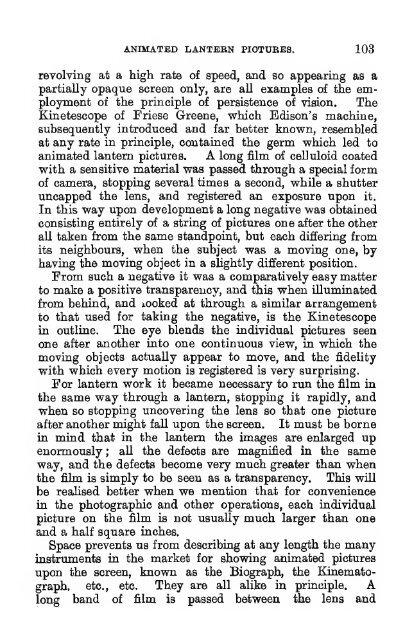Modern magic lanterns; a guide to the ... - Yesterday Image
Modern magic lanterns; a guide to the ... - Yesterday Image
Modern magic lanterns; a guide to the ... - Yesterday Image
- No tags were found...
You also want an ePaper? Increase the reach of your titles
YUMPU automatically turns print PDFs into web optimized ePapers that Google loves.
ANIMATED LANTEBN PIOTUEES. 103revolving at a high rate of speed, and so appearing as apartially opaque screen only, are all examples of <strong>the</strong> employmen<strong>to</strong>f <strong>the</strong> principle of persistence of vision. TheKinetescope of Friese Greene, which Edison's machine,subsequently introduced and far better known, resembledat any rate in principle, contained <strong>the</strong> germ which led <strong>to</strong>animated lantern pictures. A long film of celluloid coatedwith a sensitive material was passed through a special formof camera, s<strong>to</strong>pping several times a second, while a shutteruncapped <strong>the</strong> lens, and registered an exposure upon it.In this way upon development a long negative was obtainedconsisting entirely of a string of pictures one after <strong>the</strong> o<strong>the</strong>rall taken from <strong>the</strong> same standpoint, but each differing fromits neighbours, when <strong>the</strong> subject was a moving one, byhaving <strong>the</strong> moving object in a slightly different position.From such a negative it was a comparatively easy matter<strong>to</strong> make a positive transparency, and this when illuminatedfrom behind, and lOoked at through a similar arrangement<strong>to</strong> that used for taking <strong>the</strong> negative, is <strong>the</strong> Kinetescopein outline. The eye blends <strong>the</strong> individual pictures seenone after ano<strong>the</strong>r in<strong>to</strong> one continuous view, in which <strong>the</strong>moving objects actually appear <strong>to</strong> move, and <strong>the</strong> fidelitywith which every motion is registered is very surprising.For lantern work it became necessary <strong>to</strong> run <strong>the</strong> film in<strong>the</strong> same way through a lantern, s<strong>to</strong>pping it rapidly, andwhen so s<strong>to</strong>pping uncovering <strong>the</strong> lens so that one pictureafter ano<strong>the</strong>r might faU upon <strong>the</strong> screen. It must be bornein mind that in <strong>the</strong> lantern <strong>the</strong> images are enlarged upenormously; aU <strong>the</strong> defects are magnified in <strong>the</strong> sameway, and <strong>the</strong> defects become very much greater than when<strong>the</strong> film is simply <strong>to</strong> be seen as a transparency. This wiUbe realised better when we mention that for conveniencein <strong>the</strong> pho<strong>to</strong>graphic and o<strong>the</strong>r operations, each individualpicture on <strong>the</strong> film is not usually much larger than oneand a half square inches.Space prevents us from describing at any length <strong>the</strong> manyinstruments in <strong>the</strong> market for showing animated picturesupon <strong>the</strong> screen, known as <strong>the</strong> Biograph, <strong>the</strong> Kinema<strong>to</strong>graph.etc., etc. They are all alike in principle. Along band of film is passed between <strong>the</strong> lens and





